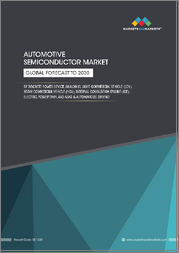
|
시장보고서
상품코드
1530877
세계의 반도체 시장 : 재료 유형, 컴포넌트, 용도, 지역별 분석 예측(-2030년)Semiconductors Market Forecasts to 2030 - Global Analysis By Material Type, Component, Application and By Geography |
||||||
세계의 반도체 시장 규모는 2024년 7,158억 9,000만 달러를 차지하고 예측 기간 동안 복합 연간 성장률(CAGR) 17.1%를 나타낼 전망이며 2030년에는 1조 8,458억 2,000만 달러에 이를 것으로 예측됩니다. 반도체는 도체(금속 등)와 절연체(유리 등)의 중간 전기 전도성을 갖는 재료입니다. 반도체는 현대 전자의 기본이며 트랜지스터, 다이오드, 집적 회로와 같은 디바이스의 골격을 형성하고 있습니다. 이 선택성은 전류를 제어하고 조작하는 데 매우 중요하며 전자 스위치와 앰프를 만드는 데 필수적입니다. 이 특성은 전자(또는 정공: 전자가 존재할 수 있는 공공)의 흐름을 정확하게 제어할 수 있는 전자 부품의 설계에 이용됩니다.
에릭슨에 따르면 5G 계약 수는 2022년 1분기에 7,000만 건 증가하여 약 6억 2,000만 건에 달했습니다.
에너지 효율성과 지속가능성의 중시의 향상
반도체 산업은 에너지 효율성과 지속가능성의 중시가 높아짐에 따라 큰 진화를 이루고 있습니다. 환경에 미치는 영향에 대한 세계의 의식이 높아짐에 따라, 기술을 포함한 모든 분야에서 에너지 소비와 탄소 발자국의 감소에 대한 관심이 커지고 있습니다. 전자기기의 중요한 구성요소인 반도체는 이러한 지속가능성으로의 전환에 매우 중요한 역할을 합니다. 반도체 재료와 설계의 발전은 성능을 희생하지 않고 전력 소비를 줄이는 에너지 효율적인 칩으로 이어지고 있습니다.
비용 압력
비용 압력은 반도체 산업을 현저하게 방해합니다. 이러한 압력은 재료비 상승, 고가의 제조 공정을 필요로 하는 첨단기술에 대한 수요 증가, 공급체인에 영향을 미치는 지정학적 긴장 등 다양한 요인으로 인해 발생하고 있습니다. 반도체 업체들은 자동차, 가전, 통신 등 분야에서 높아지는 전자기기 수요에 부응하려고 노력하고 있지만, 연구개발, 생산설비, 원재료 상승에 직면하고 있습니다.
클라우드 컴퓨팅 서비스 및 데이터센터 성장
클라우드 컴퓨팅은 방대한 처리 능력, 메모리, 스토리지 용량을 필요로 하는 데이터센터에 크게 의존하고 있으며, 첨단 반도체 기술 수요를 견인하고 있습니다. 이러한 기술에는 복잡한 계산 작업을 효율적으로 처리하도록 설계된 고성능 프로세서, 메모리 칩 및 특수 하드웨어 가속기가 포함됩니다. 또한 가상화, 인공지능(AI), 머신러닝(ML)의 동향은 이러한 수요를 더욱 증폭시키고 있습니다. AI 및 ML 알고리즘은 대규모 데이터 세트를 실시간으로 처리 및 분석하기 위한 강력한 GPU와 전용 칩이 필요하며, 이는 자율주행차에서 자연언어 처리까지 폭넓은 용도에 필수적입니다.
지적 재산 보호
반도체 산업의 지적 재산(IP) 보호는 칼날의 칼입니다. 혁신을 보호하고 크리에이터가 발명으로부터 이익을 얻도록 함으로써 연구개발 투자를 촉진하는 한편, 큰 과제도 안고 있습니다. 반도체 기업은 종종 특허를 둘러싼 장기적인 법정 투쟁에 직면하여 기술 혁신을 막고 기술 진보를 방해할 수 있습니다. 반도체 기술은 복잡하고 폭넓기 때문에 사소한 기술 혁신이라도 특허계쟁의 대상이 될 수 있으며, 기업은 다수의 지적재산권에 관한 클레임을 처리해야 하는 단편적인 상황에 빠져 있습니다.
COVID-19의 영향:
COVID-19의 유행은 반도체 산업에 큰 영향을 미쳤습니다. 당초 세계의 공급망의 혼란으로 인해 중요한 부품과 재료가 부족하여 자동차 및 전자기기 등 반도체에 의존하는 다양한 분야의 생산에 지장을 주었습니다. 락다운과 규제도 제조업무와 물류에 영향을 미치고, 칩의 생산이나 유통에 지연이 발생했습니다. 그러나 유행시 소비자 행동의 변화는 노트북, 태블릿 단말기, 게임기 등의 전자 기기에 대한 수요를 증가시켜 수급 격차를 악화시켰습니다.
예측 기간 동안 갈륨 비소 부문이 최대가 될 전망입니다.
예측 기간 동안 갈륨 비소 부문이 최대가 될 것으로 예상됩니다. 갈륨비소(GaAs)는 화합물 반도체로, 실리콘에 비해 뛰어난 전자 특성을 가지므로, 특히 고주파,고출력 용도로 각광을 받고 있습니다. 실리콘보다 높은 전자 이동도와 낮은 잡음 지수를 나타내며, 고주파(RF), 마이크로파, 밀리미터 파 디바이스에 사용하기에 이상적입니다. 반도체 디바이스에서 GaAs는 전계 효과 트랜지스터(FET), 헤테로 접합 바이폴라 트랜지스터(HBT), 집적 회로(IC)의 제조에 사용되며, 실리콘 기반 동급으로 달성할 수 있는 주파수를 초과하는 주파수에서 동작합니다.
예측 기간 동안 이산 전력 장치 부문의 복합 연간 성장률(CAGR)이 가장 높을 것으로 예상됩니다.
이산 전력 장치 부문은 예측 기간 동안 가장 높은 복합 연간 성장률(CAGR)이 예상됩니다. 다이오드, 트랜지스터, 사이리스터 등의 컴포넌트를 포함하는 이산 전력 장치는 전자 회로의 전력 흐름을 관리하고 전기 에너지를 효율적으로 변환 및 제어하는 데 중요한 역할을 합니다. 이산 전력 장치의 최근 발전은 스위칭 속도, 전력 처리 능력, 에너지 효율과 같은 성능 지표를 개선하는 데 중점을 둡니다. 실리콘 카바이드(SiC) 및 질화 갈륨(GaN)과 같은 광대역 갭 재료 개발과 같은 기술 혁신을 통해 이러한 디바이스는 에너지 손실을 최소화하면서 높은 주파수와 온도에서 작동할 수 있습니다. 되었습니다.
최대 점유율을 차지하는 지역
예측 기간 동안 북미는 시장에서 가장 큰 점유율을 차지했습니다. 스마트폰은 프로세서, 메모리 칩, 센서, 디스플레이 드라이버 등의 반도체 부품에 크게 의존하고 있으며, 이들 모두가 이 지역의 기능과 성능에 필수적입니다. 보다 진보된 스마트폰에 대한 소비자 수요가 증가함에 따라, 지역 전반에 걸쳐 이러한 디바이스에 전력을 공급하기 위한 보다 진보된 반도체 기술의 필요성도 증가하고 있습니다. 선도적 인 하이테크 기업과 반도체 제조업체의 본거지 인 북미는 생산, 기술 혁신 및 반도체 제조 시설에 대한 투자 증가를 통해이 동향에서 이익을 얻고 있습니다.
복합 연간 성장률(CAGR)이 가장 높은 지역:
유럽은 예측 기간 동안 수익성 있는 성장을 유지할 것으로 예측됩니다. 소비자와 기업 모두 디지털 통신, 스트리밍 서비스, 클라우드 컴퓨팅에 대한 의존도가 높아짐에 따라 이 지역 전체에서 첨단 반도체 부품의 요구가 급증하고 있습니다. 마이크로프로세서, 메모리 칩, 고속 데이터 컨버터 등의 이러한 컴포넌트는 지역 전체에서 보다 빠른 데이터 전송 및 처리 능력을 실현하는 데 필수적입니다. 또한 5G 네트워크 및 사물인터넷(IoT) 디바이스와 같은 기술의 부상이 이 수요를 더욱 증폭하고 있으며, 지역 전체에서 데이터 처리량 증가에 대응하고 신뢰성을 유지할 수 있는 반도체 솔루션이 필요합니다. 합니다.
사용자 정의 무료 제공:
이 보고서를 구독한 고객은 다음 무료 맞춤설정 옵션 중 하나를 받을 수 있습니다.
- 기업 프로파일
- 추가 시장 기업의 종합적 프로파일링(3개사까지)
- 주요 기업의 SWOT 분석(3개사까지)
- 지역 세분화
- 고객의 관심에 응한 주요국 시장 추계,예측,복합 연간 성장률(CAGR)(주: 타당성 확인에 따름)
- 경쟁 벤치마킹
- 제품 포트폴리오, 지리적 존재, 전략적 제휴에 기반한 주요 기업 벤치마킹
목차
제1장 주요 요약
제2장 서문
- 개요
- 이해관계자
- 조사 범위
- 조사 방법
- 데이터 마이닝
- 데이터 분석
- 데이터 검증
- 조사 접근
- 조사 정보원
- 1차 조사 정보원
- 2차 조사 정보원
- 전제조건
제3장 시장 동향 분석
- 성장 촉진요인
- 억제요인
- 기회
- 위협
- 용도 분석
- 신흥 시장
- COVID-19의 영향
제4장 Porter's Five Forces 분석
- 공급기업의 협상력
- 구매자의 협상력
- 대체품의 위협
- 신규 참가업체의 위협
- 경쟁 기업간 경쟁 관계
제5장 세계의 반도체 시장 : 재료 유형별
- 게르마늄
- 실리콘
- 갈륨비소
- 질화갈륨
제6장 세계의 반도체 시장 : 컴포넌트별
- 로직 디바이스
- 센서
- 이산 전력 장치
- 메모리 디바이스
제7장 세계의 반도체 시장 : 용도별
- 네트워킹과 커뮤니케이션
- 데이터 처리
- 산업
- 가전
- 자동차
- 발전
- 통신
- 기타 용도
제8장 세계의 반도체 시장 : 지역별
- 북미
- 미국
- 캐나다
- 멕시코
- 유럽
- 독일
- 영국
- 이탈리아
- 프랑스
- 스페인
- 기타 유럽
- 아시아태평양
- 일본
- 중국
- 인도
- 호주
- 뉴질랜드
- 한국
- 기타 아시아태평양
- 남미
- 아르헨티나
- 브라질
- 칠레
- 기타 남미
- 중동 및 아프리카
- 사우디아라비아
- 아랍에미리트(UAE)
- 카타르
- 남아프리카
- 기타 중동 및 아프리카
제9장 주요 발전
- 계약/파트너십/협업/합작투자(JV)
- 인수와 합병
- 신제품 발매
- 사업 확대
- 기타 주요 전략
제10장 기업 프로파일링
- Analog Devices, Inc
- Broadcom Inc
- Infineon Technologies
- Intel Corporation
- Kyocera Corporation
- Marvell Technology Group
- NXP Semiconductors
- Powertech Technology Inc
- Renesas Electronics Corporation
- Screen Holdings Co. Ltd
- Sony Semiconductor Solutions Corporation
- United Microelectronics Corporation
According to Stratistics MRC, the Global Semiconductors Market is accounted for $715.89 billion in 2024 and is expected to reach $1,845.82 billion by 2030 growing at a CAGR of 17.1% during the forecast period. Semiconductors are materials that have electrical conductivity between that of conductors (like metals) and insulators (like glass). They are fundamental to modern electronics, forming the backbone of devices like transistors, diodes, and integrated circuits. This selectivity is crucial for controlling and manipulating electrical currents, which is essential for creating electronic switches and amplifiers. This property is exploited in the design of electronic components where the flow of electrons (or holes, which are vacancies where electrons could exist) can be precisely regulated.
According to Ericsson, the number of 5G subscriptions increased by 70 million during the first quarter of 2022, reaching about 620 million.
Market Dynamics:
Driver:
Increasing emphasis on energy efficiency and sustainability
The semiconductor industry is experiencing a significant evolution driven by increased emphasis on energy efficiency and sustainability. As global awareness of environmental impacts grows, there is a heightened focus on reducing energy consumption and carbon footprints across all sectors, including technology. Semiconductors, crucial components in electronic devices, play a pivotal role in this shift toward sustainability. Advancements in semiconductor materials and designs are leading to more energy-efficient chips that consume less power without compromising performance.
Restraint:
Cost pressures
Cost pressures are significantly impeding the semiconductor industry. These pressures arise from various factors, including rising material costs, increased demand for advanced technologies requiring expensive manufacturing processes, and geopolitical tensions affecting supply chains. As semiconductor manufacturers strive to meet the escalating demand for electronics in sectors like automotive, consumer electronics, and telecommunications, they face mounting expenses in research and development, production facilities and raw materials.
Opportunity:
Growth in cloud computing services and data centers
Cloud computing relies heavily on data centers that require vast amounts of processing power, memory, and storage capacity, driving the demand for advanced semiconductor technologies. These technologies include high-performance processors, memory chips, and specialized hardware accelerators designed to handle complex computational tasks efficiently. Moreover, the trend towards virtualization, artificial intelligence (AI), and machine learning (ML) further amplifies this demand. AI and ML algorithms require powerful GPUs and specialized chips to process and analyze large datasets in real-time, which are essential for applications ranging from autonomous vehicles to natural language processing.
Threat:
Intellectual property protection
Intellectual property (IP) protection in the semiconductor industry is a double-edged sword. While it safeguards innovations and encourages research and development investments by ensuring creators can profit from their inventions, it also poses significant challenges. Semiconductor companies often face prolonged legal battles over patents, which can stifle innovation and hinder technological progress. The complexity and breadth of semiconductor technologies mean that even minor innovations can be subject to patent disputes, leading to a fragmented landscape where companies must navigate numerous IP claims.
Covid-19 Impact:
The Covid-19 pandemic significantly impacted the semiconductor industry. Initially, disruptions in global supply chains led to shortages of critical components and materials, hampering production across various sectors reliant on semiconductors, such as automotive and electronics. Lockdowns and restrictions also affected manufacturing operations and logistics, causing delays in chip production and distribution. However, shifts in consumer behavior during the pandemic increased demand for electronics, including laptops, tablets, and gaming consoles, exacerbating the supply-demand gap.
The Gallium Arsenide segment is expected to be the largest during the forecast period
Gallium Arsenide segment is expected to be the largest during the forecast period. Gallium arsenide (GaAs) is a compound semiconductor that has gained prominence for its superior electronic properties compared to silicon, particularly in high-frequency and high-power applications. It exhibits a higher electron mobility and lower noise figure than silicon, making it ideal for use in radio frequency (RF), microwave, and millimeter-wave devices. In semiconductor devices, GaAs is used to manufacture field-effect transistors (FETs), heterojunction bipolar transistors (HBTs), and integrated circuits (ICs) that operate at frequencies exceeding those achievable with silicon-based counterparts.
The Discrete Power Devices segment is expected to have the highest CAGR during the forecast period
Discrete Power Devices segment is expected to have the highest CAGR during the forecast period. Discrete Power Devices, which include components like diodes, transistors, and thyristors, play a crucial role in managing power flow within electronic circuits, converting and controlling electrical energy efficiently. Recent advancements in discrete power devices have focused on improving performance metrics such as switching speed, power handling capabilities and energy efficiency. Technological innovations, such as the development of wide-bandgap materials like silicon carbide (SiC) and gallium nitride (GaN), have enabled these devices to operate at higher frequencies and temperatures while minimizing energy losses.
Region with largest share:
North America region commanded the largest share of the market over the extrapolated period. Smartphones rely heavily on semiconductor components such as processors, memory chips, sensors and display drivers, all of which are essential for their functionality and performance across the region. As consumer demand for more advanced smartphones grows, so does the need for more sophisticated semiconductor technologies to power these devices throughout the region. North America, home to major tech giants and semiconductor manufacturers, benefits from this trend through increased production, innovation, and investment in semiconductor manufacturing facilities.
Region with highest CAGR:
Europe region is projected to hold profitable growth during the forecast period. As consumers and businesses alike rely more on digital communication, streaming services and cloud computing, there is a burgeoning need for advanced semiconductor components across the region. These components, such as microprocessors, memory chips, and high-speed data converters, are crucial for enabling faster data transmission and processing capabilities across the region. Moreover, the rise of technologies like 5G networks and Internet of Things (IoT) devices further amplifies this demand, necessitating semiconductor solutions that can handle increased data throughput and maintain reliability across the region.
Key players in the market
Some of the key players in Semiconductors market include Analog Devices, Inc, Broadcom Inc, Infineon Technologies, Intel Corporation, Kyocera Corporation, Marvell Technology Group, NXP Semiconductors, Powertech Technology Inc, Renesas Electronics Corporation, Screen Holdings Co. Ltd, Sony Semiconductor Solutions Corporation and United Microelectronics Corporation.
Key Developments:
In March 2023, Envision Energy, an Envision Group subsidiary providing the world's leading green technology, announced that it has started adopting Analog Devices, Inc. (Micro Electromechanical Systems) MEMS sensor technology in its new generation of smart wind turbines.
In March 2023, Samsung Electronics Co., Ltd., the global leader in innovative memory technology, and NAVER Corporation, a leading internet company, collaborated to develop hyper-scale semiconductor solutions for Artificial Intelligence (AI) Models.
In February 2023, Qualcomm Technologies Inc. and NEC Corporation announced the continuation of the cooperation to promote the commercialization of next-generation networks with their latest 5G vDU powered with the X100 5G Accelerator card.
In December 2022, Global Chip Manufacturer Qualcomm Technologies introduced its WiFi-7 capable chipsets as a part of its new immersive home platform that supports high-speed connections.
Material Types Covered:
- Germanium
- Silicon
- Gallium Arsenide
- Gallium Nitride
Components Covered:
- Logic Devices
- Sensors
- Discrete Power Devices
- Memory Devices
Applications Covered:
- Networking & Communications
- Data Processing
- Industrial
- Consumer Electronics
- Automotive
- Power Generation
- Telecommunication
- Other Applications
Regions Covered:
- North America
- US
- Canada
- Mexico
- Europe
- Germany
- UK
- Italy
- France
- Spain
- Rest of Europe
- Asia Pacific
- Japan
- China
- India
- Australia
- New Zealand
- South Korea
- Rest of Asia Pacific
- South America
- Argentina
- Brazil
- Chile
- Rest of South America
- Middle East & Africa
- Saudi Arabia
- UAE
- Qatar
- South Africa
- Rest of Middle East & Africa
What our report offers:
- Market share assessments for the regional and country-level segments
- Strategic recommendations for the new entrants
- Covers Market data for the years 2022, 2023, 2024, 2026, and 2030
- Market Trends (Drivers, Constraints, Opportunities, Threats, Challenges, Investment Opportunities, and recommendations)
- Strategic recommendations in key business segments based on the market estimations
- Competitive landscaping mapping the key common trends
- Company profiling with detailed strategies, financials, and recent developments
- Supply chain trends mapping the latest technological advancements
Free Customization Offerings:
All the customers of this report will be entitled to receive one of the following free customization options:
- Company Profiling
- Comprehensive profiling of additional market players (up to 3)
- SWOT Analysis of key players (up to 3)
- Regional Segmentation
- Market estimations, Forecasts and CAGR of any prominent country as per the client's interest (Note: Depends on feasibility check)
- Competitive Benchmarking
- Benchmarking of key players based on product portfolio, geographical presence, and strategic alliances
Table of Contents
1 Executive Summary
2 Preface
- 2.1 Abstract
- 2.2 Stake Holders
- 2.3 Research Scope
- 2.4 Research Methodology
- 2.4.1 Data Mining
- 2.4.2 Data Analysis
- 2.4.3 Data Validation
- 2.4.4 Research Approach
- 2.5 Research Sources
- 2.5.1 Primary Research Sources
- 2.5.2 Secondary Research Sources
- 2.5.3 Assumptions
3 Market Trend Analysis
- 3.1 Introduction
- 3.2 Drivers
- 3.3 Restraints
- 3.4 Opportunities
- 3.5 Threats
- 3.6 Application Analysis
- 3.7 Emerging Markets
- 3.8 Impact of Covid-19
4 Porters Five Force Analysis
- 4.1 Bargaining power of suppliers
- 4.2 Bargaining power of buyers
- 4.3 Threat of substitutes
- 4.4 Threat of new entrants
- 4.5 Competitive rivalry
5 Global Semiconductors Market, By Material Type
- 5.1 Introduction
- 5.2 Germanium
- 5.3 Silicon
- 5.4 Gallium Arsenide
- 5.5 Gallium Nitride
6 Global Semiconductors Market, By Component
- 6.1 Introduction
- 6.2 Logic Devices
- 6.3 Sensors
- 6.4 Discrete Power Devices
- 6.5 Memory Devices
7 Global Semiconductors Market, By Application
- 7.1 Introduction
- 7.2 Networking & Communications
- 7.3 Data Processing
- 7.4 Industrial
- 7.5 Consumer Electronics
- 7.6 Automotive
- 7.7 Power Generation
- 7.8 Telecommunication
- 7.9 Other Applications
8 Global Semiconductors Market, By Geography
- 8.1 Introduction
- 8.2 North America
- 8.2.1 US
- 8.2.2 Canada
- 8.2.3 Mexico
- 8.3 Europe
- 8.3.1 Germany
- 8.3.2 UK
- 8.3.3 Italy
- 8.3.4 France
- 8.3.5 Spain
- 8.3.6 Rest of Europe
- 8.4 Asia Pacific
- 8.4.1 Japan
- 8.4.2 China
- 8.4.3 India
- 8.4.4 Australia
- 8.4.5 New Zealand
- 8.4.6 South Korea
- 8.4.7 Rest of Asia Pacific
- 8.5 South America
- 8.5.1 Argentina
- 8.5.2 Brazil
- 8.5.3 Chile
- 8.5.4 Rest of South America
- 8.6 Middle East & Africa
- 8.6.1 Saudi Arabia
- 8.6.2 UAE
- 8.6.3 Qatar
- 8.6.4 South Africa
- 8.6.5 Rest of Middle East & Africa
9 Key Developments
- 9.1 Agreements, Partnerships, Collaborations and Joint Ventures
- 9.2 Acquisitions & Mergers
- 9.3 New Product Launch
- 9.4 Expansions
- 9.5 Other Key Strategies
10 Company Profiling
- 10.1 Analog Devices, Inc
- 10.2 Broadcom Inc
- 10.3 Infineon Technologies
- 10.4 Intel Corporation
- 10.5 Kyocera Corporation
- 10.6 Marvell Technology Group
- 10.7 NXP Semiconductors
- 10.8 Powertech Technology Inc
- 10.9 Renesas Electronics Corporation
- 10.10 Screen Holdings Co. Ltd
- 10.11 Sony Semiconductor Solutions Corporation
- 10.12 United Microelectronics Corporation



















